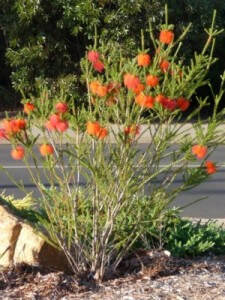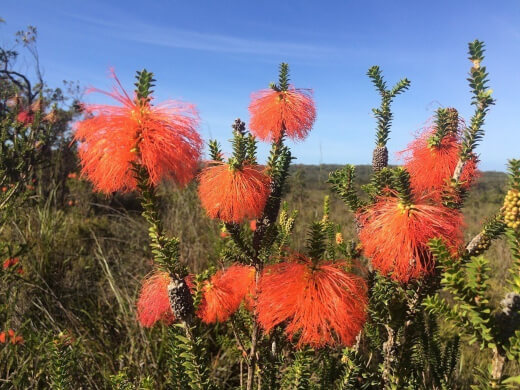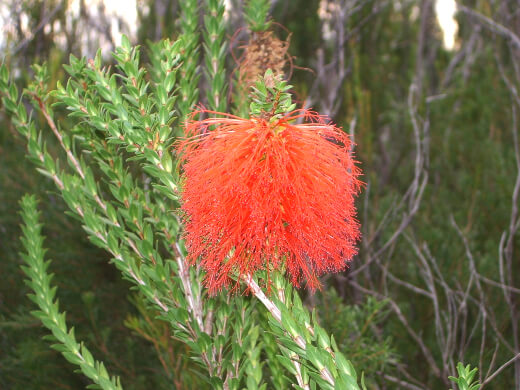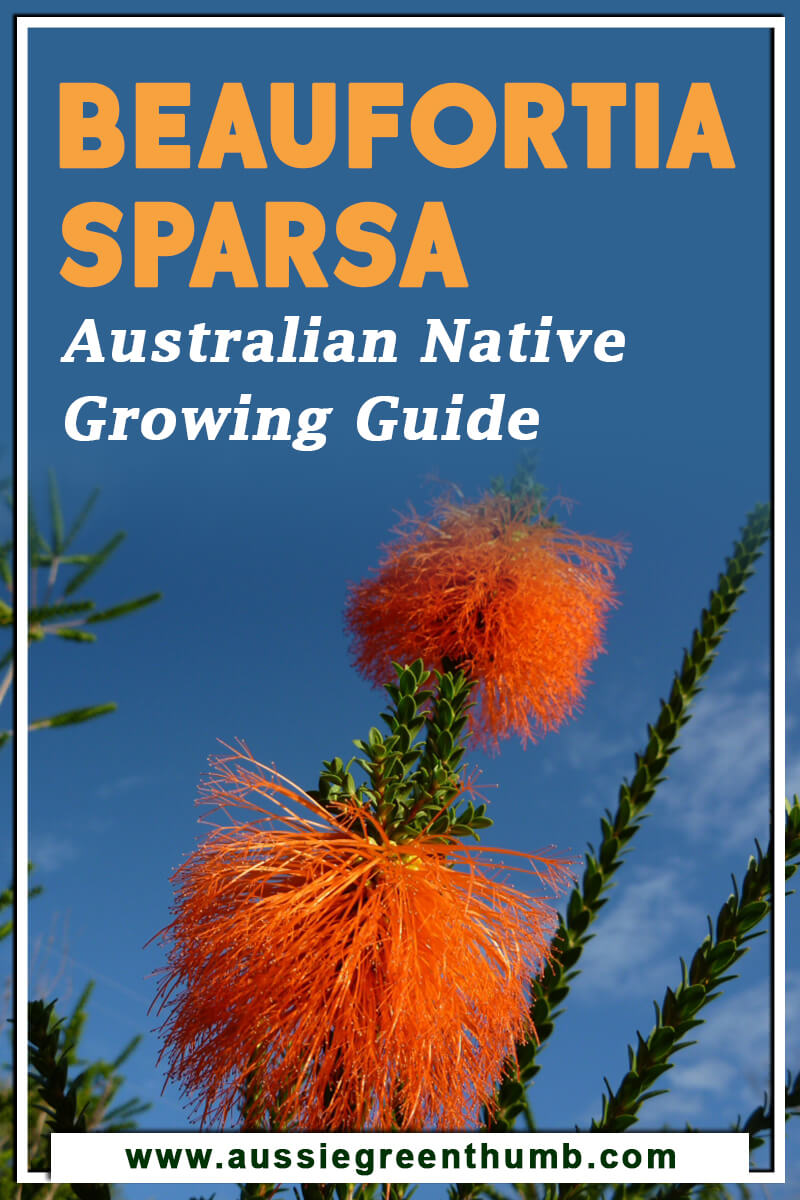The Beaufortia sparsa, more affectionately known as the Swamp bottlebrush is an incredible cultivar with brilliant blooms that will bring beauty and brilliance to your garden throughout the spring and summer.
Tall-growing and incredibly tolerable, the swamp bottlebrush is an ideal choice for a range of garden environments across Australia. Considering a new plant to add a pop of colour to your flower beds?
Here is everything you need to know to cultivate, care for and grow Beaufortia sparsa.
More...
Beaufortia sparsa Features
Family: Myrtaceae
Genus: Beaufortia
Species: B. sparsa
Common Name: Southwest bottlebrush and Swamp bottlebrush
Flower Colour: Red
Foliage Colour: Green
Growth Habit: Shrub 1m
Flowering: Autumn

The Beaufortia species is part of the Myrtaceae family, which includes over 22 brilliantly flowering, native plants that are often referred to as bottlebrushes. Although not considered typical bottlebrush plants, their vibrant flower clusters do resemble those of the Callistemon.
Beaufortia sparsa is a smaller growing shrub, stemming from Western Australia, which is prized for its showy nature. Considered an ideal feature plant, it generally grows to 2 to 3 metres and thrives in both dry and moist environments.
Commonly called the swamp bottlebrush or southwest bottlebrush, this cultivar blooms readily from the beginning of spring and the nectar-rich blooms are known to attract a range of local birds, nectar-feeding wildlife to gardens.
How to Grow Beaufortia sparsa

The swamp bottlebrush is an incredibly versatile plant, which means no matter where you may decide to grow yours, you shouldn’t have too much issue.
Still, it’s important to note that it has a very low salt tolerance, so in coastal regions, it may be advisable in a raised bed or large container to avoid concern about salt-laden soils.
Soil Needed for Southwest Bottlebrush
This species can survive in arid and overly moist soils – provided that the soils have sufficient drainage. Whether sandy, loam or clay soils, your planting site won’t require too much preparation.
Again, salty or highly acidic soils can result in root issues. If concerned, it’s best to keep the soil at a pH level between 5.5 and 6.5.
If you’re thinking of growing yours in a container, it is vital to choose a freely draining potting medium and ensure the pot has sufficient drainage holes to avoid waterlogging.
Light Needs
As with most flowering plants, the swamp bottlebrush flowers best when grown in full sunlight. However, it’s known to adapt to the dappled sun and even mostly shaded areas.
In shaded areas, keep an eye on your foliage. Should you start to notice pale leaves and flowers, it may be preferable to give your plants a little more sun.


Get Your Free Guide:
Master Growing Australian Natives eBook
A Must Have Complete Guide for Every Australian Garden
Get Your Free Guide:
Master Growing Australian Natives eBook
A Must Have Complete Guide for Every Australian Garden
Climate Needs
Beaufortia sparsa is perfectly adapted to the Australian climate. However, it is not overly frost tolerant, so may need a little protection in particularly cold winters.
Propagating Swamp Bottlebrush

Source: davesgarden.com
These plants can be freely propagated from seed or from cutting. Of course, many growers cut out the hassle by purchasing an existing original plant from a local native nursery.
However, if you’re happy to put in the little extra effort, propagating new beaufortia plants is a straightforward and cost-effective process.
Southwest Bottlebrush Propagation from Seed
Seed pods can be collected from plants, right after the time of flowering. Unlike other native species, seed pods don’t open their own and will need a little bit of a nudge before planting. Here is what you need to do:
- Place seed pods into a coffee grinder. Allow the seeds to be ground up for 30 seconds or so.
- Sow the debris onto a porous seeding mixture. The seeds will be contained in the debris and will germinate pretty freely from here.
- Keep your seedling in a warm and sunny spot, taking care to keep the soil moist and not wet until they germinate.
- When seedlings are large enough to handle, they can be replanted.
Propagation from Cutting
Cuttings can take slightly longer to begin to root, so you may need some patience. Cuttings should be taken during the growing season for the best results.
Be sure to only take cuttings from healthy, thriving plants. Simply, follow general cutting instructions for natives. Avoid taking cuttings from wild plants where you cannot guarantee plant health.
Dieback is a problematic disease that is affecting many plants across Australia. Introducing a cutting with a potential dieback infection can cause a devastating spread throughout the entire garden.
Planting Your Beaufortia sparsa

Source: wikipedia.org
Whether you’ve purchased your plants from a local nursery or your seedlings are ready to grow, the planting instructions are fairly similar.
Here is what you’ll need to do:
- Dig a large enough hole for the root ball or seedling.
- Loosen the soil slightly before placing the root ball into the hole.
- Backfill with the remaining soil and gently pat down to secure the base of the plant.
- Water well for the first few days after planting.
Caring for Beaufortia sparsa
The swamp bottlebrush is a fairly low-maintenance plant. Young plants, however, will require some additional care until they become established.
Watering Beaufortia sparsa
Young plants should be kept moist for the first few months. Then, watering can be cut back to a semi-regular routine. Avoid overwatering in moist air which tends to retain moisture. As a rule of thumb, allow the soil to dry out in between to avoid any rot issues.
Fertiliser
Beaufortias are known to tolerate low-nutrient soils fairly well. Still, you can consider adding a low-phosphorus, native fertiliser annually to support plants and encourage superior blooming results.
In the spring and summertime, the blooms make for fantastic cut flowers. Cutting back flowers also provides the perfect opportunity to do a little pruning and remove seeds.
Pruning Swamp Bottlebrush
Pruning should be fairly light, mainly done to control shape and size. Take care to remove any damaged or diseased parts of the plant to prevent any spread.
Taking Care of Cut Beaufortia Flowers

Source: lullfitz.com.au
If you’re looking to create a brilliant native bouquet, cut away flowers with half-open buds for the best results. Avoid cutting away flowers that are faded or wilted, as these will die off pretty quickly.
Once removed, trim off the bottom 1 to 2 cm of the stem and strip away any leaves which would potentially be sitting in water. Prepare a vase with fresh water and a good, native plant preservative.
For longevity, keep flowers in a cooler area which will prevent flowers from wilting too quickly. Check on your water regularly and replace it the moment it becomes misty.
Beaufortia sparsa Pests, Problems & Diseases
This is a hardy plant, so unless exposed to common garden pests you really shouldn’t come across too many issues. Should an issue arise, it’s best to use natural treatments before grabbing anything with chemicals.
Final Swamp Bottlebrush Growing Tips
- Mature plants are incredibly drought tolerant, so don’t worry too much if you forget to water your plants. Less can be more with this species.
- While it’s not necessary, if you’re planning on adding some fertiliser to your plants, do so just before the growing season for the best results.
- If growing beaufortias in a region that experiences a cooler climate, plants may need to be protected from frost. Consider keeping plants as a summer patio plant or in a greenhouse.
- For a fuller garden effect, consider growing a few beaufortia varieties together. The different varieties bloom in a range of colours from red, purple, orange and pink which can make for a beautiful garden spectacle.
Beaufortia sparsa Frequently Asked Questions
Why is Beaufortia sparsa called the Swamp Bottle brush?
B. sparsa is commonly called the Swamp Bottlebrush. Part of the Myrtle family, it produces intense orange flowers that develop in spiked, upright forms, identical to bottle brush trees, but with a late-season similarity to red hot pokers too.
They are happiest in damp conditions with moving water, and have become a common sight in bogs and wetlands.
Is Beaufortia sparsa an Australian native?
B. sparsa is native to Australia and endemic to southwestern parts of Western Australia. They grow equally well in coastal sand, swamps, or wetlands near streams and rivers.
And are happiest in warm summers, where its wetland habit retains moisture without increased humidity.
Does Beaufortia sparsa like humid conditions?
B. sparsa does not like humid conditions and rarely flowers fully in cool or humid gardens. If you are looking for wetland plants, or plants for damp gardens, this is ideal, but it will need to be planted in full sun to minimise the natural humidity of those conditions.
When does Beaufortia sparsa flower?
B. sparsa flowers from January to April, or September to November. In some parts of Australia, it will flower twice in a year, in others, you will either get late or early flowering. Woody fruits replace the flowers and remain in place until they are eaten by birds or pruned.
How do you recognise Beaufortia sparsa?
B. sparsa is easy to recognise. Not only does it have distinct flowers with dense but fine red-orange stamens, its leaves grow in dense strings, covering sprawling stems, similar to rosemary or lavender but with a distinctly upright habit.
Is Beaufortia sparsa a rare plant?
B. sparsa is incredibly common, both in cultivation and in nature, and is not a threatened plant species according to the Western Australian Government Department of Biodiversity, Conservation and Attractions.
How tall is Beaufortia sparsa?
B. sparsa grows to 3m tall after about eight years, but will continue bushing out to fill that form for up to fifteen years. Pruning Beaufortia can help to bush out the lower branches sooner, but it is relatively fast growing and looks best when left to its own natural patterns.
Does Beaufortia sparsa spread?
B. sparsa spreads out to a width of about 3m, and forms a messy dome of shrubbery in garden borders. For gardens run on a budget, it’s a great way to achieve equal height and width, with all the impact that comes with flowering Australian natives.
Is Beaufortia sparsa invasive?
B. sparsa is not invasive, and while it can seed quite happily around the garden, it rarely does in cultivated settings without help. Its roots are not damaging either, and when grown with good moisture levels it will rarely root wider or deeper than the top growth.
Is Beaufortia sparsa good for bees?
B. sparsa is useful for bees and butterflies, but has less scent than other bottlebrush plants and therefore less nectar. The main attraction for wildlife is the proliferous seed pods, which are held on the plant right through the cooler months for a source of foraged food for birds and small mammals.
Is Beaufortia sparsa a Myrtle?
B. sparsa is a member of the Myrtle family, but a distinct genus in its own right. The fragrant foliage is a key clue to its heritage, while the bottlebrush flowers help to cement its place in that iconic family of native Australian trees and shrubs.
Can I grow Beaufortia sparsa in pots?
If you have very poor drainage or standing water below the topsoil in your garden Beaufortia sparsa will actually grow better in pots. However, don’t be too afraid of trying these plants in slightly damp conditions as they are native swamp plants and will grow anywhere damp, provided the water is moving and drains.

Enjoy Growing Beaufortia sparsa in Your Garden
If a little bit of brilliance and vibrance is what you’re looking for in your garden, then there is no better choice than the swamp bottlebrush. Whichever environment you decide to grow yours, your Beaufortia sparsa should have no issues establishing itself and giving you the most gorgeous few and visitors in your garden.
Published on January 20, 2023 by Lorri Hopkins
Last Updated on January 19, 2025




